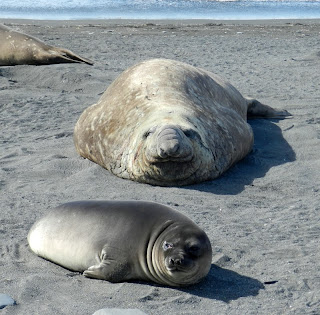Touring South Georgia Island
 |
| South Georgia Island |
South Georgia Island is as beautiful
a place as you can find on earth.
Magnificent snow and glacier-covered mountains coming down to the deep
blue Southern Ocean, and steep, grassy
valleys cut by the glaciers.
Today was clear so we had sun, bright blue sky, and lots of wind.
 |
| South Georgia glacier |
Yesterday, we visited Stromness Bay
in the afternoon to see its enormous collection of birds and seals. This morning we took a Zodiac tour along the
2 mile front of a glacier that is rapidly receding (nearly 1000 feet per year),
so calving constantly. After one
particularly large calving this morning, our Zodiac driver turned the boat and
headed full speed out of the cove, followed by an even faster mini-tsunami wall
of water displaced by the falling ice.
It finally dissipated and back we went to continue our inspection.
There are hundreds of birds circling
around the front side of the glacier.
The area where fresh water from the glacier meets cold salty sea water
is rich in fish and shellfish, so excellent feeding grounds for many species of
birds and seals. South Georgia has thousands of fur and elephant seals and
hundreds of thousands of birds. But, it
also has rats that were introduced a century ago by visiting ships, and they
eat birds’ eggs. The small research
group that lives on the Island estimates that there would be 100 million birds
nesting here if it weren’t for the rats.
They have embarked on a major rat eradication program that is very
difficult and very expensive, but also very successful in their test area. It would be incredible to come back here in a
decade and see if the bird population has, indeed, grown that much, assuming
the rats are completely eradicated.
 |
| King Penguin breeding colony with chicks |
The King Penguins are thick here and
most are molting, which is quite a fascinating process. The penguins stay in one place, mostly
standing, for the 4 or 5 weeks it takes to molt. Consequently, they lose about 1/3 of their
body weight and must return immediately to the ocean for food when their
molting is finished. Often, they go
hundreds of miles out to sea to feed.
When they molt, they don’t just shed feathers. The new feathers push out the old feathers,
so they look shaggy over parts of their bodies while other parts, which haven’t
started molting yet, look sleek and normal.
At the same time, there are breeding
pairs hatching eggs and feeding chicks, so the parent sitting on the egg eats
nothing for 2 or 3 weeks while the other parent goes out to sea to feed. Then they exchange places until the chick is
old enough to be left alone, covered in soft brown feathers. These chicks form themselves into groups for
protection as they are too young to take care of themselves or to swim long
distances. When the parents return from
the ocean, they often have trouble finding their chick, but the chick can find
them because the baby is hungry and smells its parents and runs after them
squawking until it gets fed.
 |
| Male elephant seal resting |
This afternoon, we spent 4 hours at
Grytviken, an old Norwegian whaling station (there were 7 or 8 on South Georgia
before whaling was banned by the British in 1965). This is where Ernest Shackleton is buried,
with his head facing south, as he wished, in a small cemetery above the water
and below the towering cliffs of the mountains and glaciers. Shackleton died of a heart attack while en
route to South Georgia to launch yet another attempt to cross Antarctica.
 |
| White fur seal protecting his territory |
In its heyday, Grytviken had 400
workers and could process 25 whales a day, using every part of the whale’s
body. It must have been a slimy,
gruesome place, but very lucrative for the whalers. They killed 175,000 whales here over about 50
years. Then, one season, when they
returned, there were no whales at all.
They had killed so many that the population collapsed. The Japanese whalers took over the station
for a couple of years, but gave it up because it was so unproductive. The town now is home to 30 fishery
administrators, researchers, and rat eradicators, some of whom have lived here
for 20 years, taking 3 or 4 months of vacation during the darkest days of
winter. It’s a life they love, but obviously
completely isolated, the only way out being boat or, occasionally, a helicopter. The nearest land is the Falkland Islands,
nearly 800 miles away. Nonetheless, they
have about 5000 visitors a year from tourist, fishing, and British Navy ships
stopping here and seem very pleased to show their visitors around.






















































